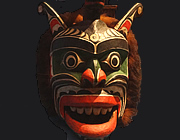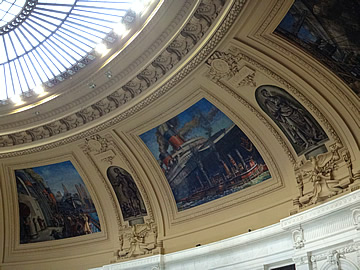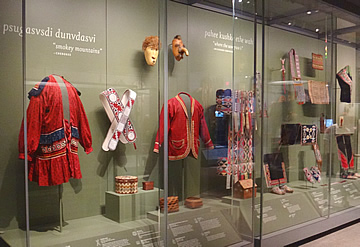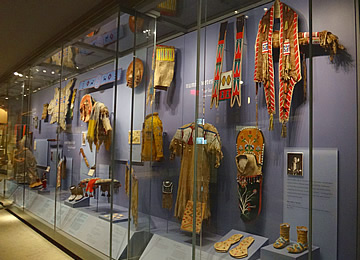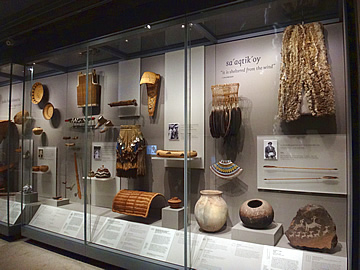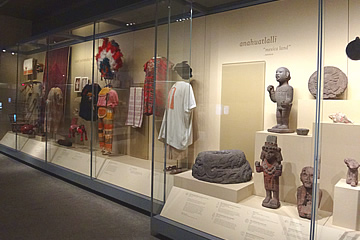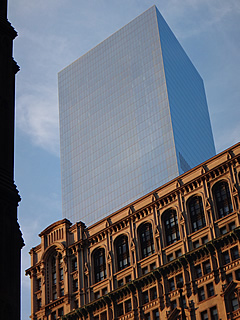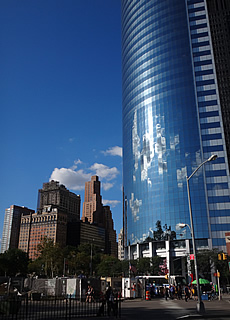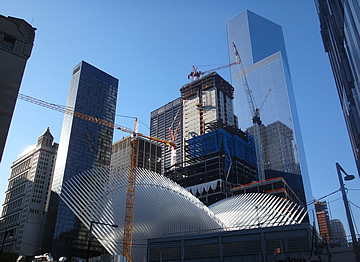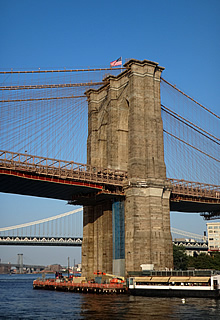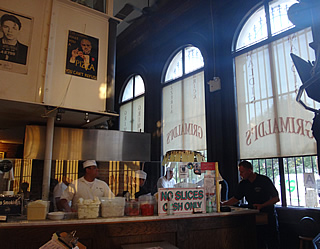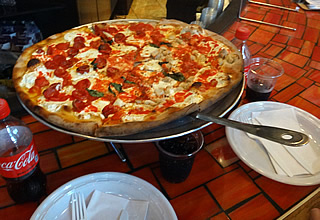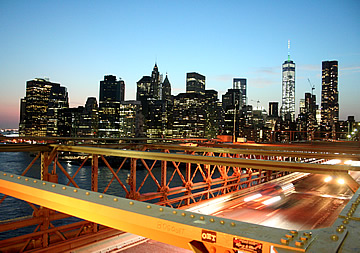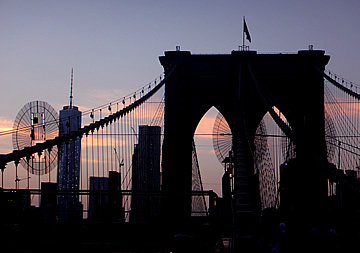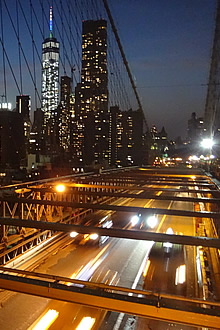Battery Park

From the ferry to Liberty Island: on the right is the edge of Battery Park, the long white building on Pier A was a municipal building now renovated and converted to leisure use including a bar and restaurant. Freedom Tower in the background.
We were staying in Lower Manhattan so that we could visit places we'd not been to before, particularly to be close to ferries and the World Trade Centre.
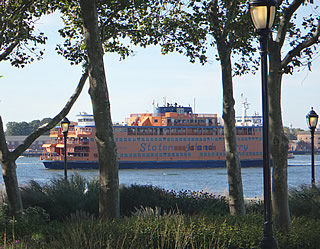
Staten Island Ferry seen from Battery Park.
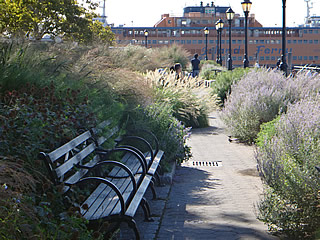
Typical Piet Oudolf planting in Battery Park.
Battery Park occupies the southern tip of Manhattan and was completely renovated in 2003. The gardens constitute a Garden of Remembrance for victims and survivors of 9/11 and were designed by Piet Oudolf in his trademark naturalistic style. It's a peaceful haven and well looked after.
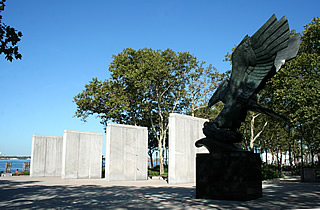
Second World War Memorial
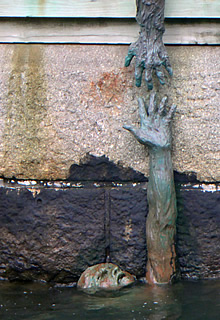
American Merchant Mariners' Memorial
Within the park is circular Castle Clinton, once a fort built to defend the harbour and also once the major processing centre for immigrants before Ellis Island took over the task. Now it houses a ticket centre for ferries to Liberty Island and Ellis Island which leave from the docks here. Not very far east is the ferry to Staten Island.
There are some very fine memorials in the park including the wonderful American Merchant Mariners' Memorial depicting shipwrecked mariners.
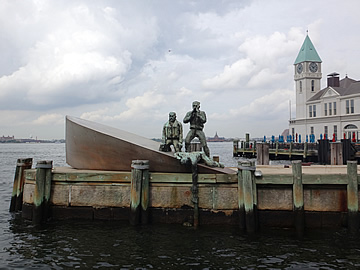
American Merchant Mariners' Memorial
National Museum of the American Indian
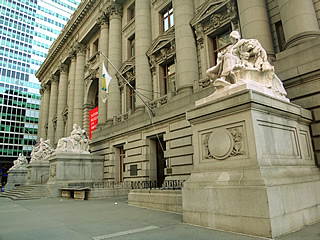
The four sculptures represent the great trading states of the early twentieth century: America, Asia, Europe, and Africa.
Nearby is the National Museum of the American Indian, one of the places I really wanted to look into. It is housed in a large classical building, the Alexander Hamilton U.S. Customs House, and is part of the Smithsonian Institution.1
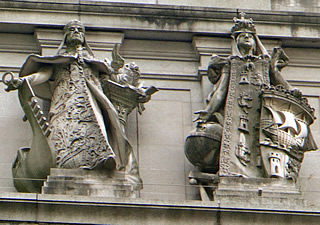
Sculptures on the facade represent the sea powers of Europe and the Mediterranean.
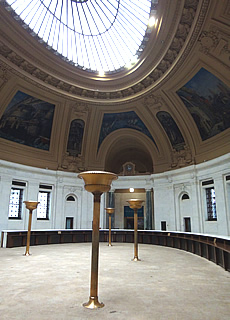
The oval domed hall of the former customs house.
The building houses a collection of artefacts belonging to diverse native cultures of the Americas from South America north to Canada and Caribbean islands.
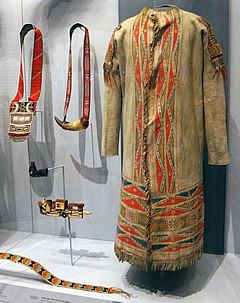
Cree Coat
Alberta, Canada, ca. 1780-1820
Hide, paint, porcupine quill, hair.
"Made from a single moose hide, this northern Cree coat wraps around the body as it once wrapped around the animal, the wearer's spine aligned with the spine of the animal."
The displays are excellent - comprehensive without being daunting. The costumes, especially ceremonial clothing, can be very ornate, though everyday tools and implements are quite primitive.
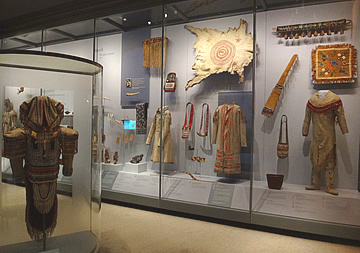
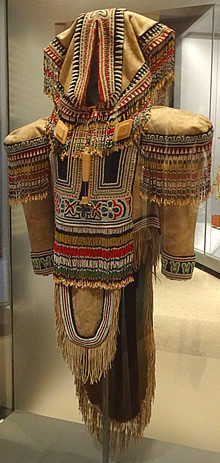
Inuit amauti or tuilli (woman's parka). Chesterfield Inlet, Nunavut, Canada, ca. 1890-1925.
Caribou skin, glass beads, stroud cloth, caribou teeth, metal pendants, ivory, seal hide.
This garment looks so elaborate, surely it was for special occasions.
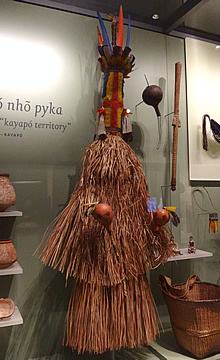
Karaja ijaso mask and rattles
Bananal Island, Brazil, ca. 1930-1960
Babassu palm, reed, feathers of macaw, roseate spoonbill, Amazon parrot and harpy eagle, gourd.
"Ijaso masks are always made in pairs, and represent spirits which come to Karaja villages during the dry season."
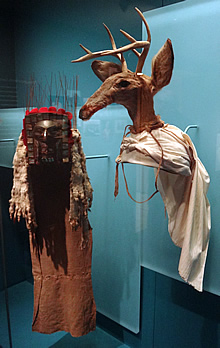
Yoeme deer dance headdress.
Sonora, Mexico, ca. 1910.
Deer hide, glass eyes, antlers.
"Yoeme have always believe they exist in close communion with all the inhabitants of the Sonoran Desert. Contemporary Yoeme regard the deer dance and songs as the most essential expression of what it means to be Yoeme, and its practitioners as the embodiment of their survival as a people."
It was interesting just how many tribes there were I had never heard of. Inuit, Navajo, Hopi, Sioux etc. are all very familiar, but Anishinaabe, Kwakwaka'wakw, and many more were completely unknown to me.
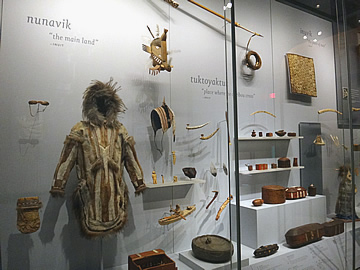
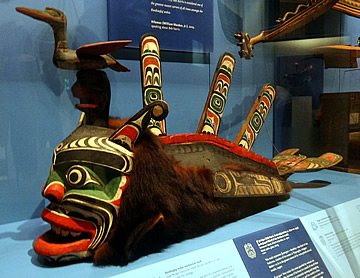
Kwakwaka'wakw mechanical mask.
Cape Mudge, Vancouver Island, British Columbia ca. 1900.
Wood, paint, fur, cordage.
"This large fish mask, worn on the back of a ceremonial dancer, may represent Namxilagiyu, a halibut-like sea monster."
Image captions are from museum information labels.
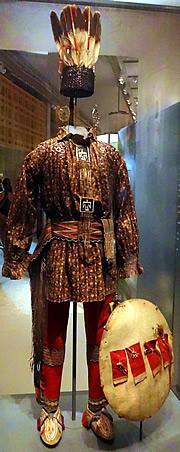
Anishinaabe outfit collected by Andrew Foster.
Fort Michilimackinac, Michigan, ca. 1790.
Birch bark, cotton, linen, wool, feathers, silk, silver brooches, porcupine quills, horsehair, hide, sinew.
Dakota Shield
Fort Michilimackinac, Michigan, ca. 1790.
Buffalo hide, wool, porcupine quills, paint, deer hair fur, dye.
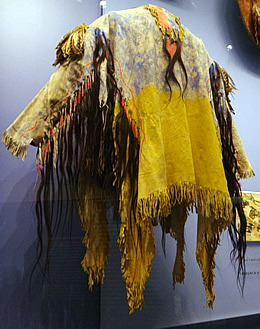
Shirt associated with Tashunca-uitco (Crazy Horse, Oglala Lakota, 1849-1877).
South Dakota, ca. 1870s.
Hide, human- and horsehair, quill, pigment, woodpecker feathers, arrowhead, cocoon.
"Captain John Bourke writes that this Lakota war shirt was presented to him by Little Big Man, who led him to believe that it once belonged to the great Lakota chief Crazy Horse or at least had been worn by him."
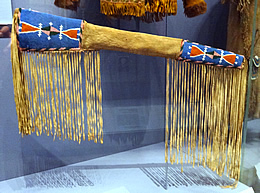
Assiniboine Rifle Case
Saskatchewan, Canada, ca. 1890
Deer hide, glass beads.
"Finely made gun cases were decorated with bead work and long fringe by several Plains groups."
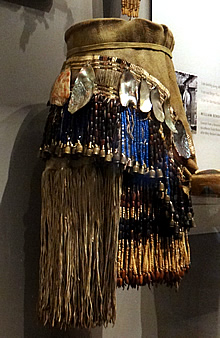
Hupa apron and skirt.
California, ca. 1900.
Hide, plant fiber, pine nuts, bear grass, abalone shell, brass thimbles, glass and seed beads.
"This style of skirt and accompanying apron are worn by Hupa, Karuk, Tolowa, Yurok, and Wiyot people during ceremonies such as the Brush Dance, a renewal ritual. This skirt is decorated with old Russian beads, abalone, and pine nuts.
How impressive the ceremonials must have been with dancers and other participants in such marvellous costumes.
I've only highlighted a fraction of the artefacts that appealed to me - it's definitely a museum to linger in.
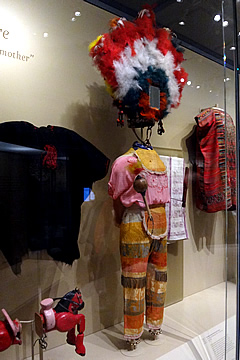
Zapotec Danza de la Pluma outfit.
Oaxaca State, Mexico, ca. 1940.
Cotton fabric, synthetic fabric, bamboo, feathers, silk, mirror, hide.
"This Zapotec outfit was worn in the Danza de la Plum, part of a fiesta that takes place annually in July. The dance retells the story of the conquest of Mexico, but allows participants to reimagine events. In this telling of history, Moctezuma is resurrected, Cortez is vanquished, and pre-contact order is restored."
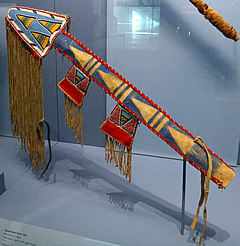
Apsáalooke Lance Case
Montana, ca. 1890
Hide, paint, wool cloth, glass beads.
"Elaborate fringed and incised rawhide cases known as sword scabbards or lance cases were carried exclusively by Apsáalooke people. Today, as in the past, they are carried by Apsáalooke women in mounted parades."
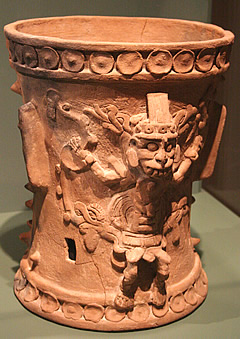
Classic period Maya incense burner depicting a warrior or deity, AD 600-900.
Quiriguá,
Izabal Department, Guatemala.
Pottery.
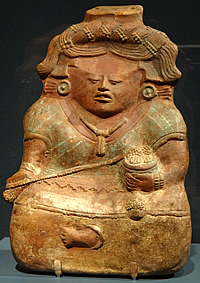
Classic period Maya whistle in the form of a seated woman, AD 600-900.
Quiché department, Guatemala.
Pottery, paint.
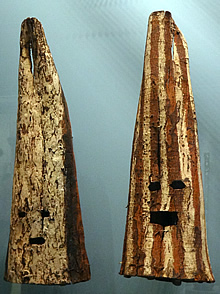
Yámana bark masks.
Tierra del Fuego Province, Argentina, ca. 1910.
Bark, paint, baleen.
"The Yámana
practiced two important ceremonies for the initiation of young men and women. The Chiexaus took place when abundant food was available so that a large group could come together for a considerable period. The Kina was a more specialised initiation for men. Participants in both held painted wands while spirits were impersonated by already initiated men wearing body paint and bark or leather masks."
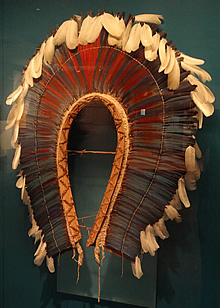
Mebengokre krokrokti (feather headdress or cape).
Brazil, ca. 1990.
Macaw feathers, heron feathers, cotton cordage.
"Mebengokre men and women wear feather headdresses or capes during children's naming ceremonies and boys' initiation ceremonies - in other words, when Mebengokre young people enter into adult life, begin to learn Mebengokre cultural knowledge, and take on Mebengokre identity."
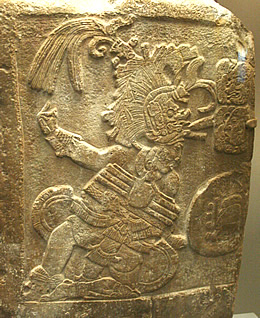
Maya bas-relief depicting a ball player.
La Corona, Petén Department, Guatemala, AD 600-750.
Limestone.
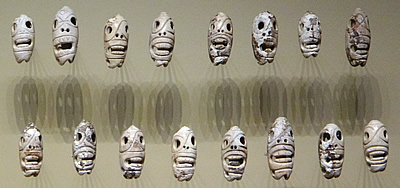
Maya skull necklace.
Campeche State, Mexico, ca. AD 600.
Olivella shells, paint.
On the streets
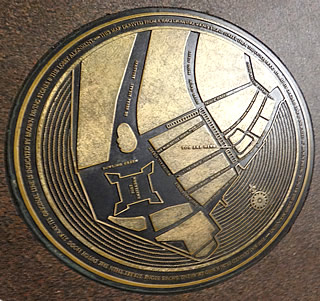
1660 map of Lower Manhattan set in the pavement at the entrance of 85 Broad Street. Fort Amsterdam and many waterways are prominent features which now no longer exist, or are at least underground!
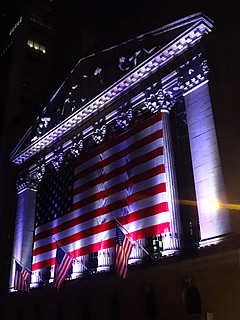
New York Stock Exchange
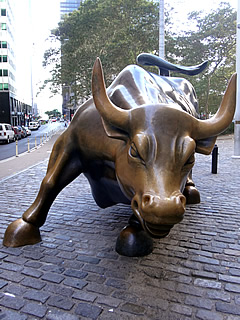 Charging Bull
Charging Bull
Arturo di Modica

Bowling Green and, beyond, the beginning of Broadway heading north.
Lower Manhattan is a fascinating area of NYC. Many visitors probably only go to the World Trade Centre or the ferry ports but we wanted to explore a little more in depth.
It encompasses the Financial District so we find the New York Stock Exchange here for instance, on Wall Street, and the wonderful Charging Bull sculpture at the northerly apex of Bowling Green - it originally appeared in front of the Stock Exchange in 1989, no-one knows how!
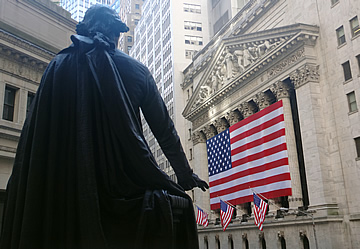
New York Stock Exchange seen from behind the statue of George Washington in front of Federal Hall.

A Farmers Market held Tuesdays & Thursdays, Broadway at Battery Pl.
The fresh fruit and vegetables looked gorgeous.
Bowling Green is a very small triangular public park - reputedly the spot where Dutch settler Peter Minuit paid Native Americans the equivalent of $24 in exchange for the whole of Manhattan Island.
I was delighted to see a Farmers' Market at the south side of Bowling Green in front of the Museum of the American Indian one afternoon - it looked so fresh and inviting.
The mix of architecture is fantastic, everything from fabulous Art Deco to brand new modernistic skyscrapers.
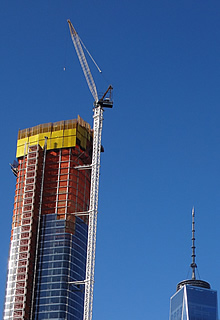
Construction never seems to stop here.
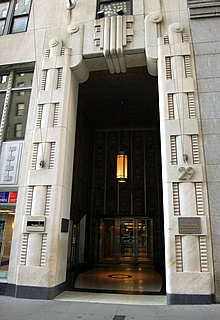
29 Broadway
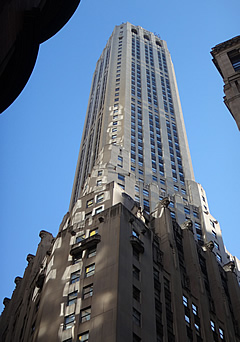
The former Farmers Trust building at 20 Exchange Place.
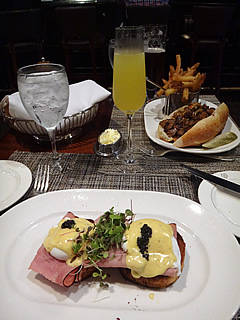
Lunch at Delmonico's on Beaver Street. Eggs Benedict was invented here so I had to try it - as expected it was excellent.
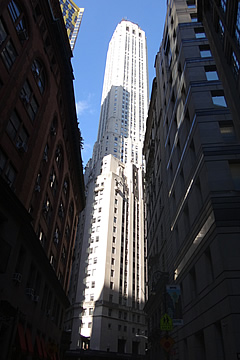
The former City Bank Farmers Trust building, completed in 1931 in fine Art Deco style.
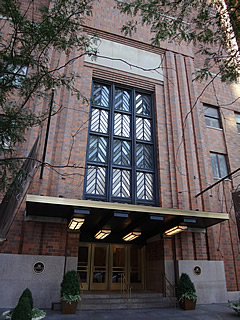
New York Athletic Club
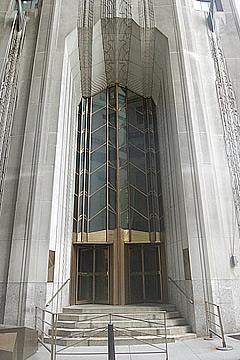
One Wall Street
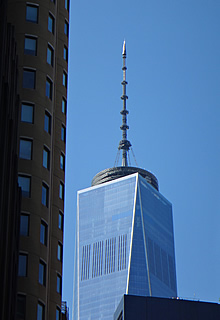
The Freedom Tower of the World Trade Center dominates the skyline of Lower Manhattan.
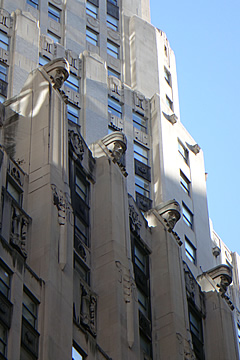
Wonderful sculpture and fine Art Deco details such as stepped levels and long vertical lines on the former Farmers Trust building.
There are a number of attractive Art Deco buildings in Lower Manhattan - the Art Deco Society of New York website2 was extremely helpful when it came to deciding which we could comfortably see during our stay and for providing more information about the buildings.
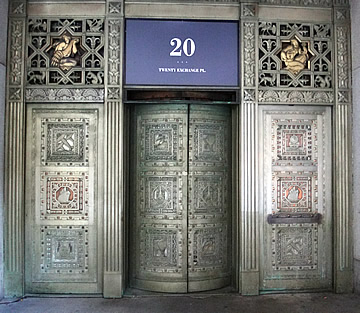
Fine entrance at 20 Exchange Place.
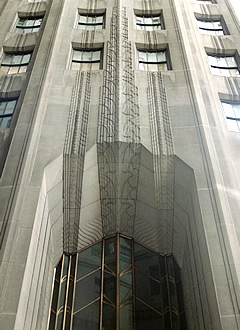
One Wall Street

Decorative panels on the American Stock Exchange illustrate the types of stocks traded.
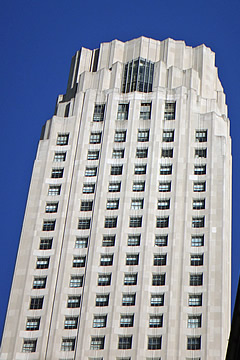
One Wall Street
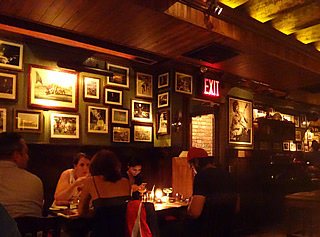
We went to Dead Rabbit on Water street for cocktails on a couple of evenings - the cocktail menu is a respectably-sized book!
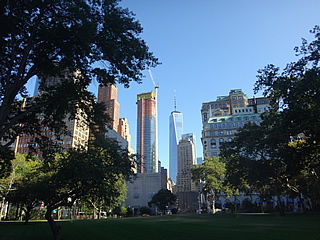
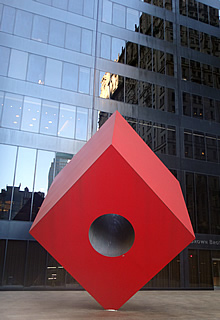 Red Cube
Red CubeIsamu Noguchi
140 Broadway
Costing an eye-watering four billion USD Santiago Calatrava's design for the transit hub at the World Trade is set to open in 2016. I think it is elegant, a soaring bird.
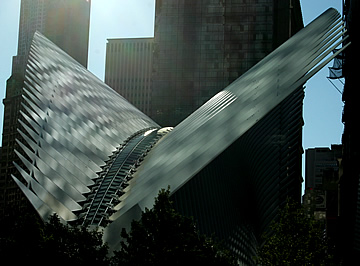
Calatrava's Transport Hub
Brooklyn Bridge
We were keen to try a highly recommended pizzeria in Brooklyn, Grimaldi's. We took the ferry across the East River, Grimaldi's is beneath Brooklyn Bridge so it was a short walk. However, it is so popular that there is almost always a queue here - we didn't have too long to wait though, maybe twenty minutes. We got in reasonably quickly because there was only two of us and we were happy to sit at the bar rather than a table.
The pizza was excellent.. Great music too and a very chatty Brooklyn waiter.
We walked back over the Brooklyn Bridge with terrific views of both the Freedom Tower and uptown to the Chrysler and just generally of the New York skyline.
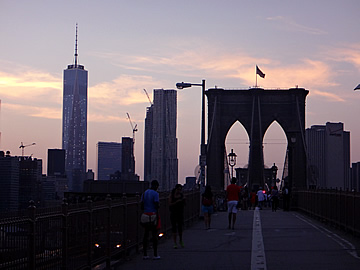
Sunset and the Freedom Tower from Brooklyn Bridge.
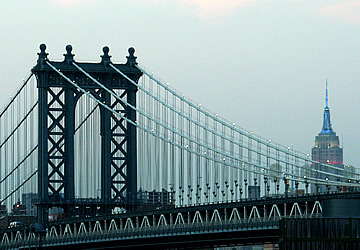
Manhattan Bridge with the Empire State Building beyond.
The central portion of the bridge is for pedestrians and cyclists, to each side are separate lanes, below this section, for motor vehicles.
It was incredibly hot. We were very tired after a long day and decided to take the subway back to the hotel - it was very nearly unbearable on the platforms.
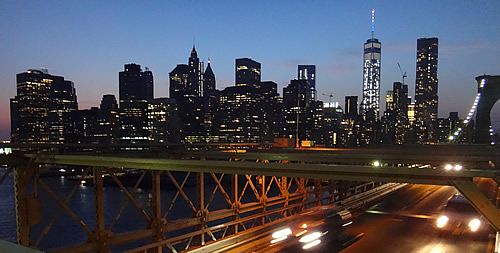
Lower Manhattan skyline from the Brooklyn Bridge.
References
- National Museum of the American Indian
- Art Deco Society of New York


